As you may have heard, this week is officially Pollinator Week! It’s not that the pollinators are aware of that, but as gardeners, it is an excuse to stop and think about the pollinators in our gardens, and consider how diverse pollinator species can be.
Over the last 48 hours I’ve been trying to pay closer attention to who is visiting which blooms in our gardens. Even though I can’t, at least not yet, identify all the different species I encountered, I can still be impressed at the diversity of species that are frequenting our flowers.
When we think of pollinators, it’s easy to automatically think of honey bees. We do keep honey bees, and although they are the obvious pollinators here, they aren’t working the gardens alone. We’re also doing what we can to encourage native bees, and other pollinator species, to visit the gardens as well.
There’s some debate as to whether or not the presence of honey bees may negatively impact the ability of native pollinators to gather nectar and pollen from the same resources in a particular area. Scientists may never be able to answer that question, as honey bees are now ubiquitous throughout North America. What is apparent though, just from casual observation, is that different bee species show preferences for different species of flowers, and this highlights the importance of plant diversity in the garden.
We have some sizable Scrophularia californica on the property this spring, and the honey bees are very obviously drawn to its nectar.
Honey bees are so large compared to some of the native bees, that the native bees, like this Ceratina sp., can be easily overlooked!
Where the honey bees at the moment are mobbing the Scrophularia, creeping thyme, and the lavender flowers, the native bees seem rather enchanted with the native Salvia and Eriophyllum blooms.
I spent quite some time lurking among the Eriophyllums, because these particular flowers seemed to attract a wide diversity of insect species compared to almost anything else in bloom here this week.

The broad flowers of Eriophyllum lanatum ‘Siskiyou’ are appealing to a wide variety of pollinator species
Different bees have different preferences for flowers, perhaps due to color or shape, but not all flowers are accessible to all bee species. This in part is due to variation in tongue length between species. Short-tongued bees can easily reach the nectar and pollen in an open flower like Eriophyllum, but may find it more difficult to access stores in long, tubular-shaped, blooms.
Some species of bees may show a preference for foraging on a single flower species. These specialist bees are said to be monolectic foragers. More commonly bees may show a preference for a particular genus, or family of flowers, and these are termed oligolectic bees. For example, some of the so-called ‘sunflower bee’ species will preferentially forage on flowers in the Asteraceae family. Polylectic bee species are considered generalists though, and will forage on a wide variety of flower types. [1] The more specialized a bee’s foraging strategy is, the more sensitive they are to changes in their environment, and habitat loss. [2]
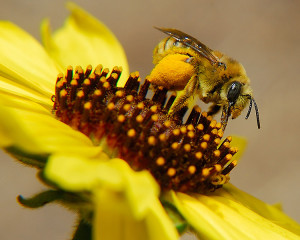
Sunflower bees are named for their preference for foraging on flowers in the Asteraceae family, like this Encelia
This preference for a species or family of blooms is why it’s important, when planting with pollinators in mind, to plant in large drifts of the same species/family of blooms.
Even if our preference is to mix up the annual or perennial borders for our own visual interest, foraging for pollinators is vastly more efficient if the same flower varieties, or families, are kept close together.
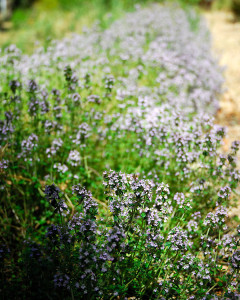
Grouping flowering plants in drifts, like this thyme, makes it easier for pollinators to find their preferred food
Bees aren’t the only winged pollinators in the gardens though.
Flies, believe it or not, can be pollinators too, especially hairy species who inadvertently drag pollen around on their bodies. I’m not encouraging the proliferation of flies in the garden, but they do play their part in pollination too, even if it’s accidental.
Syrphid flies, bee flies, and other bee-like mimics can be observed visiting the flowers in the garden too.
The bee-flies (Bombyliidae sp.) don’t seem particularly fussy where they feed in the garden. Although I frequently found them foraging among the native sage blooms, they’re just as happy feasting on Lavender or Verbena.
Nearby, despite the disguise, the eyes, antennae length, and wing shape, show this bee-mimic is also actually a fly, and seems to enjoy lurking among the native poppies.
Even this mosquito-like insect is drawn to some of the flowers.
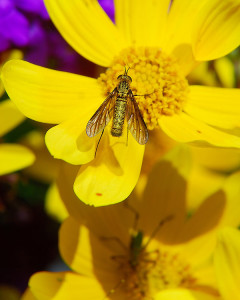
I’m not sure what species this is, but its golden coloration is quite stunning for such a small mosquito-like insect
Back to the bees though, the native sages are clearly enticing a number of bumble bee species. This spring we’ve observed lots of what appears to possibly be Bombus flavifrons [3] this year.
I don’t recall seeing this species in previous years here. These hirsute, vividly colored, bumble bees are difficult to miss, and sometimes more than a dozen were found working the same plant.
They really seem to favor the native sages, and thus far are completely ignoring the Lotus scoparius flowers, which are clearly more attractive to other bumble bee species.
The Yellow-Faced bumble bees (Bombus vosnesenskii), and Bombus bifarius, can be found working the deerweed (Lotus scoparius) flowers throughout the day.
The Eriophyllums we planted this Spring though, are also proving to be a big hit with the sweat bees, including this metallic green Agapostemon texanus.
I’d personally like to rename sweat bees, who never seem that attracted to me, no matter how much I’ve overexerted myself in the garden, to ‘zippy-I-won’t-bee-caught-on-camera bees‘.
They are almost impossible to capture with a camera, as they barely sit still long enough for the shutter to release.
Maybe for simplicity sake I’ll just call them ‘I-won’t-sit-still-bees’!
Sweat bees were also found rolling around among the poppies, gathering pollen. Although, honestly, I couldn’t quite determine which species of sweat bee these are.
Regardless, the poppies were very popular with this species of bee.
It’s not just bees though. Hoards of syrphid flies are also found among the flowers. They seem to especially favor the Hyssop in the herb garden at the moment, and the Eriophyllums in the native gardens too.
In fact, if I was to pick a peak pollinator attractor at the moment, in our gardens, that isn’t lavender, or thyme…Eriophyllum is clearly the place to be seen.
Everything loves these gloriously sunny, and radiant flowers.

Also in the Syrphidae family are the Sphegina flies, here perched on hedge parsley (Torilis arvensis)
The Eriophyllum flowers are also very attractive to butterflies. This time of year the predominant species seem to be the Skippers, including this Mournful Duskywing.
There were also quite a few Rural Skippers (Ochlodes agricola), but they succeeded in evading my lens, unlike the Woodland Skippers (Ochlodes sylvanoides) that didn’t seem to mind the camera as much.
Checkerspots (Euphydryas chalcedona) are prevalent in the gardens too.
Sharing the same flowers, an American Lady butterfly (Vanessa virginiensis).
Unfortunately, where the pollinators thrive, the predators also lurk. Pollination, in our gardens at least, is risky business.
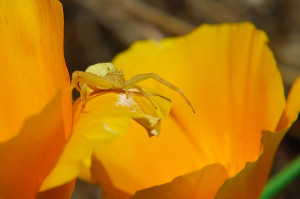
Crab spiders can change colors to better blend in with the flowers where they lurk waiting to catch prey
This Syrphid fly, enticed by the promise of nectar and pollen, met a premature end when this camouflaged crab spider snagged it for a meal.
I’m actually quite surprised at both the prevalence, and the variation in coloration of our crab spiders this season.
The next poor unsuspecting pollinator to approach this flower is in for a surprise!
In the orchard, another one of our honey bees didn’t see what else was lurking among the poppies until it was too late.
How on earth does a spider, no larger than honey bee itself, secure this for dinner?
Of course, thus far, I’ve focused on bees, and bee-like flies as the principle pollinators in our gardens. They are important pollinator species here, but others are also doing their part in the gardens too. Beetles, in fact, are important pollinators too, especially for older species of flowers.
Remember, honey bees are a relatively recent introduction to the Americas, and a number of blooms relied on beetle pollination before the arrival of the European honey bee.
Beetle species are numerous, and we have a number of different species here on the farm. Each spring, hoards of Soldier beetles can be found clustering around plants that are infested with aphids.
Aphid-hunting Lady Beetles, albeit inadvertently, can also move pollen from plant-to-plant.
These small black beetles appear predictably each year on the Encelia flowers.
Beyond the bees and beetles, we’re also finding lots of Katydids among the flowers.
Quite a few Katydid nymphs too, especially on the native poppies.
Like the Katydids, grasshoppers aren’t principle pollinators, but they may still inadvertently transfer pollen between flowers.
Birds can also be considered to be pollinators, especially the nectar feeders, like hummingbirds. This particular bird was taking a break to bathe in our recently installed rock fountain. So far we’ve watched both Anna’s and Allen’s hummingbirds enjoying a brief splash in the water as it flows over the rock.
What we don’t see are the night pollinators though. I keep thinking it would be fun, to camp out with camera at the ready, to see if I can spy any sphinx moths, or bats, on pollination patrol.

Pollinators also include creatures active at night, including moths like this Pale Beauty Moth (Campaea perlata)
Honey bees are important for crop pollination, but as their populations have declined due to mite, and disease issues in recent years, the wide variety of native pollinator species here are just as important, if not more so.
If you’re curious to see how many pollinator species are in your garden, find an accessible species of flower blooming in your garden, a broad, open, flat flower species that appeals to a diverse array of pollinator species. Then stand still, for at least 20 minutes, and see just how many different species you can observe.

Thanks to the hard working pollinators in our garden, we’ll soon have some cucumbers to look forward to
The diversity of pollinators hard at work in your garden might surprise you!
——————-
[1] Eric Mader, Matthew Shepherd, Mace Vaughn, Scott Hoffman Black. 2011. Attracting Native Pollinators: The Xerces Society Guide Protecting North America’s Bees and Butterflies.
[2] Matthew Shepherd, Stephen L. Buchmann, Mace Vaughan, Scott Hoffman Black 2003. Pollinator Conservation Handbook: A Guide to Understanding, Protecting, and Providing Habitat for Native Pollinator Insects.
[3] Jonathan Koch, James Strange, and Paul Williams. Bumble Bees of the Western United States. U.S. Forest Service, and the Pollinator Partnership.

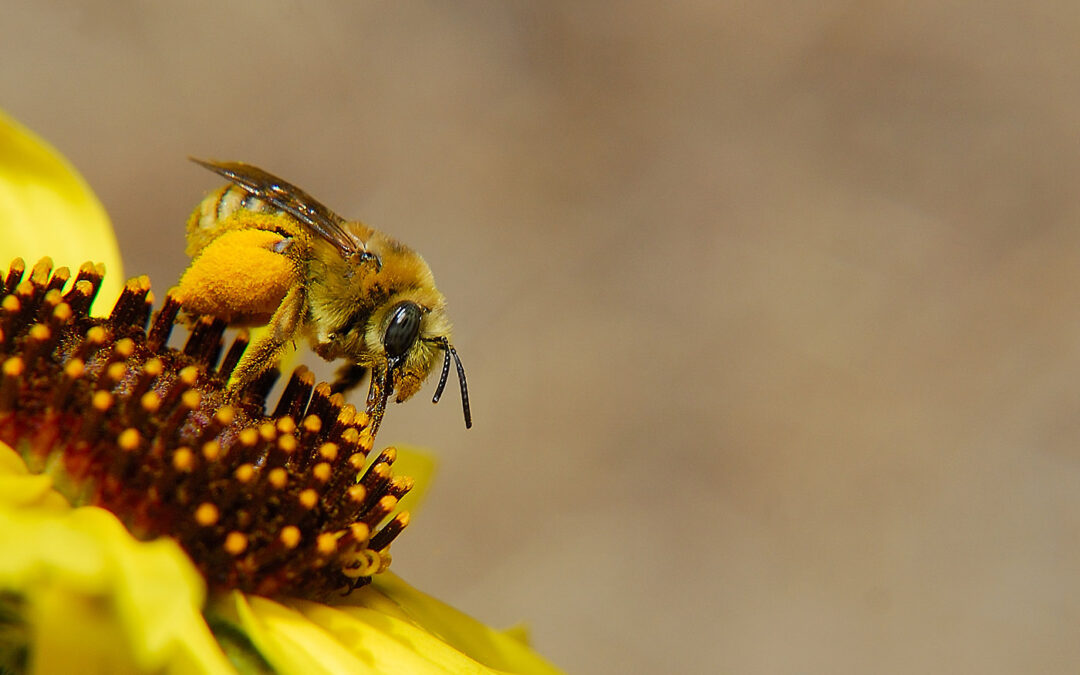

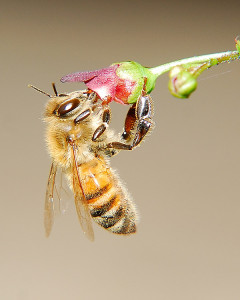

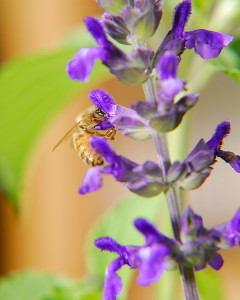
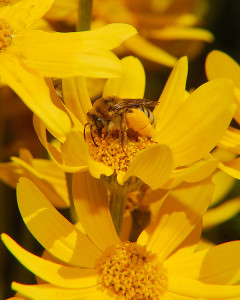

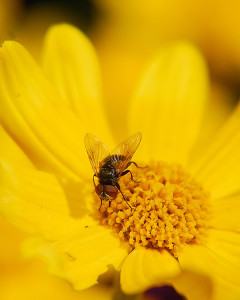
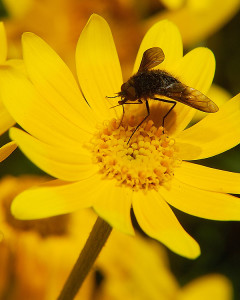
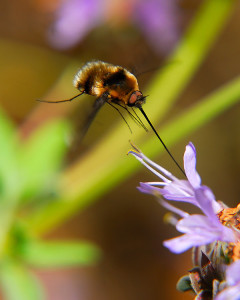
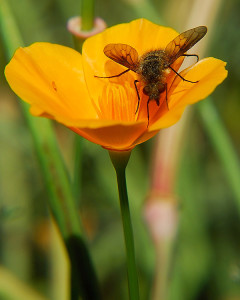
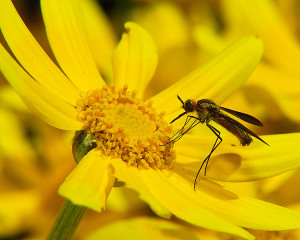
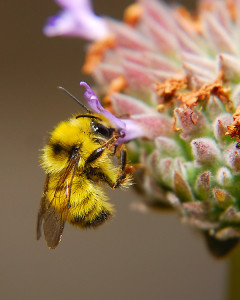


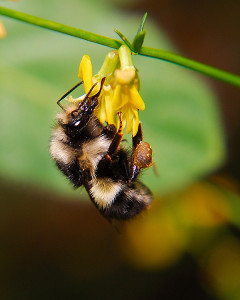
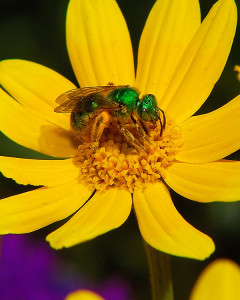
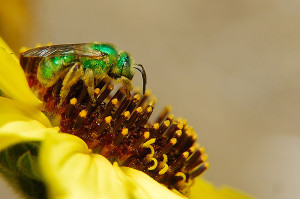

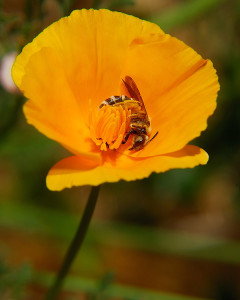



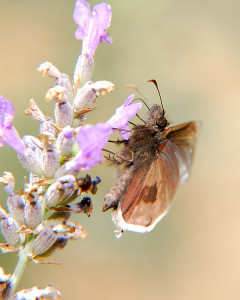
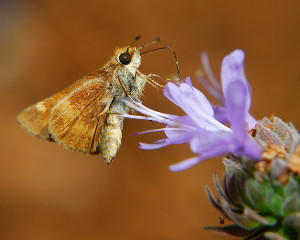
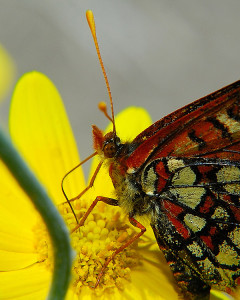
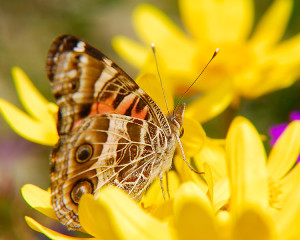

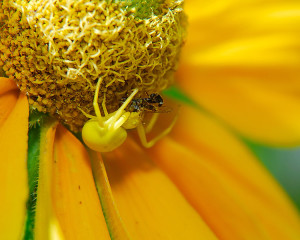

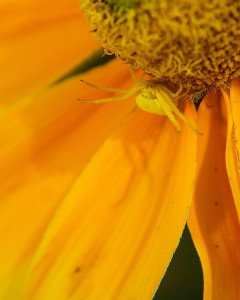


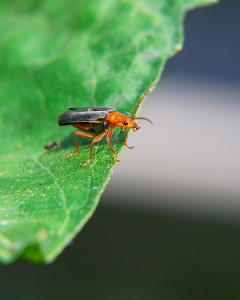

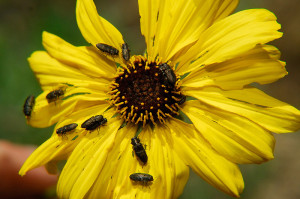


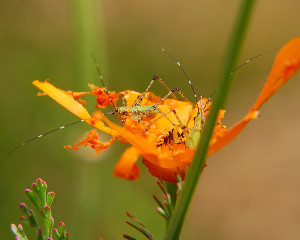
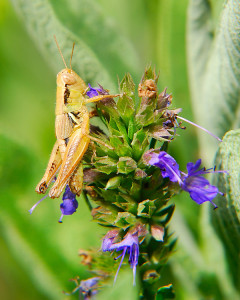








What a great set of photos! I never tire of looking at the visitors to flowers in our gardens. I am terrible at identifying them all, but I know we have a big variety of pollinators. I saw a small green bee and a giant bumblebee on the same Bee Balm flower today, but my camera was nowhere near. I say “plant it and they will come!” You are so right about the importance of plant diversity.
I don’t think it matters too much if you can’t ID them all. I certainly couldn’t, not without spending a lot more time writing this blog post 😉 For me it’s fun just seeing how many different kinds of creatures are sourcing food, shelter, or nesting sites, from the plants in the garden. I also find it interesting to spot new species I haven’t noted before, especially after adding new plants to the gardens. I clearly need to plant a LOT more Eriophyllum!
Very nice rundown and fantastic photos as always, but you forgot about ants, and the wind! 🙂
Well, I tried for wind, but it’s darned hard to photograph 😛 You’re right, those non-native Argentine ants can drag pollen around, although this spring, they mostly were just bothering our new hive splits. I have quite a love-hate relationship with ants, but most beekeepers do!
I have been taking more pictures to see what I can identify..I know there are so many buzzing insects all over the garden and hundreds of fireflies at night…I again just learned so much in this post. I adore the hummer on the fountain.
I think we often don’t think about who is running around our gardens at night, beyond the obvious things like skunks and raccoons. On the next full moon it might be interesting to take a walk up to the gardens and see if we see anyone different lurking in the flowers! The hummers are awfully cute. They seem to like how shallow the water is it spills over that rock, and we occasionally see them sipping from the top of it too.
Clare, This is a really wonderful pollinator post! Filled with good information and marvelous photos! The pollinators are thanking you! gail
Thanks Gail. I had a lot of fun hunting them with my camera. I didn’t get much else done, but at least I had fun 😉
You are so good in spotting them, and your lens is so good for them too. We also have lots of them, but my lens doesn’t do them any good!
I keep wanting to upgrade this lens, but I’m so hard on camera equipment. I have learned, through trial and error, that rather than chasing the pollinators around the garden, I find a favorite flower, and wait. Many of the bees and butterflies seem less skittish that way 😉
I really enjoyed this post, Clare. So many different pollinators and such good images. It is amazing how many hard working insects are out there if only we look really close.
I was surprised how many different insects showed up, and quite surprised how many different types of flies actually seem to forage for nectar. It’s not all about the bees!
Wow, I’m so impressed with your photos. I don’t seem to be able to get any pollinators on camera – well, all the more enjoyable to look at yours!
Thanks TM! Good strong light, and fast shutter speeds seem to be key. Oh, and patience…a large dose of patience (something I’m not always very good at) 😛
You must be very patient to be able to take all those wonderful close ups. Interesting to see the honey bee and native bee on the same flower – really points up the size difference.
Poor Sweat Bee – an ugly name for a very beautiful insect!
I didn’t get much done one morning this week, while I stalked some of these pollinators, but it was fun. Those Scrophularia flowers are quite small, about the size of my pinkie fingernail. I thought the honey bee though really helped to demonstrate just how small that Ceratina bee is. You really do have to watch some of these flowers closely to see who’s visiting!
Oh I thoroughly enjoyed the various (and many!!) pollinators in your garden. It must have required patience to get all them to “pose” for you. 🙂 THanks – it was so interesting!!
Ha! I wish they posed. I few times I was reluctant to move the camera for a better shot, so they didn’t fly off. They were quite cooperative overall though. It will be fun to do this later in the year too, and see if anyone different shows up, as some native bees, and butterflies, are active at different times of the year.
Clare,
Enjoyed this posting, the photos are wow. I think your skipper is a worn male Poanes taxiles, Taxiles Skipper, they like wodland edges and opening. Chase each other around a lot as well as people in thier sunny territories.
I don’t think it’s a Poanes taxiles, we’re too far west. Their range is east of the Rockies. That said though, the Umber Skipper (Poanes melane) does overlap in range with Ochlodes sylvanoides, and its ventral wing surface does look quite similar to the Woodland Skipper too. I don’t have any dorsal wing shots though, but I don’t remember the dorsal wing coloration being as dark as an Umber.
Wow. what a great set of pictures and a great variety of insects. I have seen many of them here but not all. You have really attracted a great many.
It was definitely more than I expected! 🙂
What a great set of photos, I would never have the patience to sit there and wait, but I guess that’s how the hard work is paid off. Very interesting post I had no idea so many insects could contribute to pollination. I always thought of the obvious bees and butterflies.
I think when I do this again, in early summer, I need to remember my hat, and use a little more sunblock 😉 It was worth it though!
Fantastic post.
Thanks Mary 🙂
What a long list of pollinators you’ve found. I’m impressed with how much activity is happening in your flowers.
I’d like to see more butterflies. We do have quite a few California Sisters (Adelpha californica), but they wouldn’t land so I could snap a pic! 😉
Very informative!Thanks for pointing out the importance of swaths of the same species of flowers. Your photos of all the different pollinators are excellent, and I think you did a great job with the illusive sweat bee! Sometimes I get a good insect photo through sheer luck, but the numbers of yours reveal real talent!
Most of my butterfly photos are usually luck. They’re quite skittish. I’ve found though, that holding my camera to my eye, and then slowly leaning forward seems to help. If I life the camera up when I’m already leaning forward, they vanish! 😛
Wonderfully informative post. I enjoyed your photos, ID’s and great photos.
Thank you Shirley, glad you enjoyed the post 🙂
I, too, have noticed that certain types of bees like certain flowers. It’s good to have this confirmed! I’ve been rather concerned that I haven’t seen any bumblebees in my garden, maybe they just prefer other types of flowers?
That is quite the proboscis on that bee-fly! A great informative article!
I’ve known it to be true for honey bees for some time. Even within the same colony, individual honey bees will have preference for a particular bloom. I’m sure some of that preference is learned through simple reward-based reinforcement. Once they find a certain flower offers good nectar, the inclination is to try another that looks the same…and why not?! 😉
I’ve been seeing various kinds of bees, wasps, butterflies, and moths working in my garden for a few weeks now — but it must be in honor of Pollinators Week that the first ruby-throated hummingbird of the year put in an appearance this past week!
I love seeing the hummers zip about the garden. I thought we mostly had Anna’s hummingbirds here, but since we cleared and planted the orchard, we’ve been seeing a lot more Allen’s hummingbirds too. I love seeing them in the fountain, splashing about, too!
Awesome set of photos. I have a Pale Beauty moth on my post today abut photographing insects at night, but I didn’t know the name until now. Thanks.
I just dropped by your post Lou, you found quite an assortment of moths! I’ve never tried setting up a rig like that to entice the night creatures toward the camera, but now I’m anxious to give it a go! 🙂
I planted quite a bit of scrophularia, and the bees ignore it. I wonder if it’s too close to the hives?
Clare – your knowledge and generosity to share always blow me away. Bees are ‘happy thoughts’, but those creepy crab spiders freak me out a bit. That whole ‘circle of life’ – I get it, but those “ucky” bugs are still “ucky” (and I am a big scaredy cat).
This post is like an episode of ‘Life on Earth’. Sweat bees aside you seem to manage to make the pollinators pose in the most captivating ways. Thrilling to see so many varieties and the wildflowers too. Happy 4th July!
Wonderful set of photos! I especially like the one of the hapless syrphid fly caught by the spider. In my garden syrphid flies are very populous around the sweet alyssum. I plant the new sterile varieties (mentioned in my latest post), but that does not seem to matter to the flies.
Wow, I feel like I just took an entomology class at Cal Poly. This was a GREAT posting.
Thank you!
Sharon